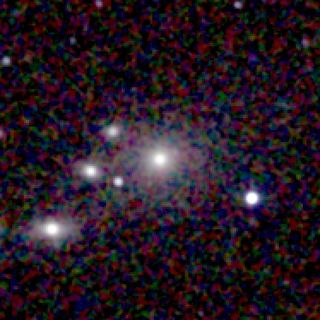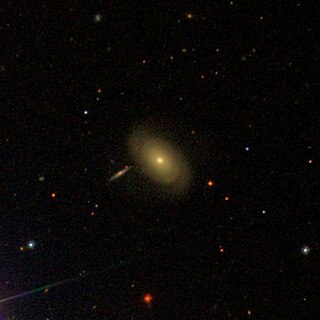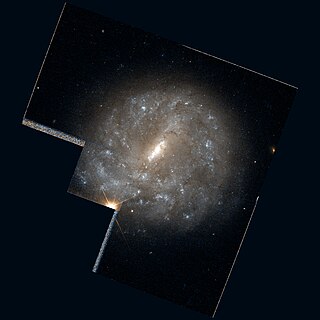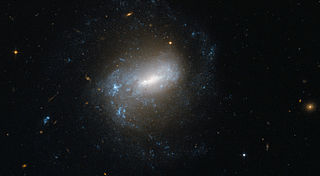
NGC 3223 is a faint spiral galaxy in the constellation Antlia. It was discovered on February 2, 1835 by the English astronomer John Herschel. The galaxy lies at a distance of approximately 110 million light years away and is receding with a heliocentric radial velocity of 2,896 km/s. The morphological class of NGC 3223 is SA(s)b, indicating it is a spiral with no central bar (SA), no inner ring feature, and moderately tightly wound spiral arms. The galactic plane is inclined at an angle of 46° to the line of sight from the Earth, with the major axis along a position angle of 128°. It has at least two well-defined arms and is flocculent in appearance.

NGC 70 is a spiral galaxy located in the constellation Andromeda. It was discovered on October 7, 1855, by R. J. Mitchell and was also observed on December 19, 1897 by Guillaume Bigourdan from France who described it as "extremely faint, very small, round, between 2 faint stars".

NGC 7012 is a large, bright elliptical galaxy located about 380 million light-years away from Earth in the constellation Microscopium. NGC 7012 was discovered by astronomer John Herschel on July 1, 1834.

NGC 4753 is a lenticular galaxy located about 60 million light-years away in the constellation of Virgo. NGC 4753 was discovered by astronomer William Herschel on February 22, 1784. It is notable for having distinct dust lanes that surround its nucleus. It is a member of the NGC 4753 Group of galaxies, which is a member of the Virgo II Groups, a series of galaxies and galaxy clusters strung out from the southern edge of the Virgo Supercluster.

NGC 3837 is an elliptical galaxy located about 290 million light-years away in the constellation Leo. It was discovered by astronomer William Herschel on April 26, 1785. NGC 3837 is a member of the Leo Cluster.

NGC 3857 is a lenticular galaxy located about 295 million light-years away in the constellation Leo. The galaxy was discovered by astronomer by Édouard Stephan on March 23, 1884. It is a member of the Leo Cluster.

NGC 3867 is a spiral galaxy located about 350 million light-years away in the constellation Leo. It was discovered by astronomer Édouard Stephan on March 23, 1884 and is a member of the Leo Cluster.

NGC 3873 is an elliptical galaxy located about 300 million light-years away in the constellation Leo. The galaxy was discovered by astronomer Heinrich d'Arrest on May 8, 1864. NGC 3873 is a member of the Leo Cluster.

NGC 3886 is a lenticular galaxy located about 280 million light-years away in the constellation Leo. It was discovered by astronomer Heinrich d'Arrest on May 9, 1864. The galaxy is a member of the Leo Cluster.

NGC 688 is a barred spiral galaxy with starburst activity located 190 million light-years away in the constellation Triangulum. It was discovered by astronomer Heinrich d'Arrest on September 16, 1865 and is a member of the galaxy cluster Abell 262.

NGC 3239 is an irregular galaxy in the constellation of Leo. It is the host of SN 2012A, the first supernova of 2012. The galaxy, which was discovered in 1784 by William Herschel, is part of the New Galactic Catalogue, and with an apparent magnitude of 13.5, is not visible to the naked eye. It has been shown to have many HII regions, while also having some star formation regions. These signs are common in galactic mergers, which is why it is believed that NGC 3239 is the result of a galactic merger. The supernova SN 2012A was discovered in this galaxy and has been classified as a type II-P supernova, with a shorter plateau and non-constant luminosity.

NGC 3705 is a barred spiral galaxy in the constellation Leo. It was discovered by William Herschel on Jan 18, 1784. It is a member of the Leo II Groups, a series of galaxies and galaxy clusters strung out from the right edge of the Virgo Supercluster.

NGC 3666 is an unbarred spiral galaxy in the constellation Leo. It was discovered by William Herschel on March 15, 1784. It is a member of the Leo II Groups, a series of galaxies and galaxy clusters strung out from the right edge of the Virgo Supercluster.

NGC 4900 is a barred spiral galaxy in the constellation Virgo. It was discovered by William Herschel on April 30, 1786. It is a member of the NGC 4753 Group of galaxies, which is a member of the Virgo II Groups, a series of galaxies and galaxy clusters strung out from the southern edge of the Virgo Supercluster.

NGC 4781 is a barred spiral galaxy in the constellation Virgo. It was discovered by William Herschel on Mar 25, 1786. It is a member of the NGC 4699 Group of galaxies, which is a member of the Virgo II Groups, a series of galaxies and galaxy clusters strung out from the southern edge of the Virgo Supercluster.

NGC 3898 is a spiral galaxy in the constellation Ursa Major. It was discovered by William Herschel on April 14, 1789.

NGC 1345 is a barred spiral galaxy in the constellation Eridanus. It was discovered by John Herschel on Dec 11, 1835.

NGC 1425, also known as IC 1988, is a spiral galaxy in the constellation Fornax. It was discovered by William Herschel on Oct 9, 1790.

NGC 3294 is a spiral galaxy in the constellation Leo Minor. It was discovered by William Herschel on Mar 17, 1787. It is a member of the Leo II Groups, a series of galaxies and galaxy clusters strung out from the right edge of the Virgo Supercluster. The galaxy is located at a distance of 98 million light years and is receding with a heliocentric radial velocity of 1,586 km/s. The morphological class of NGC 3294 is SA(rs)bc, which means this is a spiral galaxy with no central bar (SA), an incomplete inner ring structure (rs), and moderately wound spiral arms (bc).

NGC 918 is a barred spiral galaxy in the constellation Aries about 67 million light years from the Milky Way. It was discovered by John Herschel on Jan 11, 1831.




















